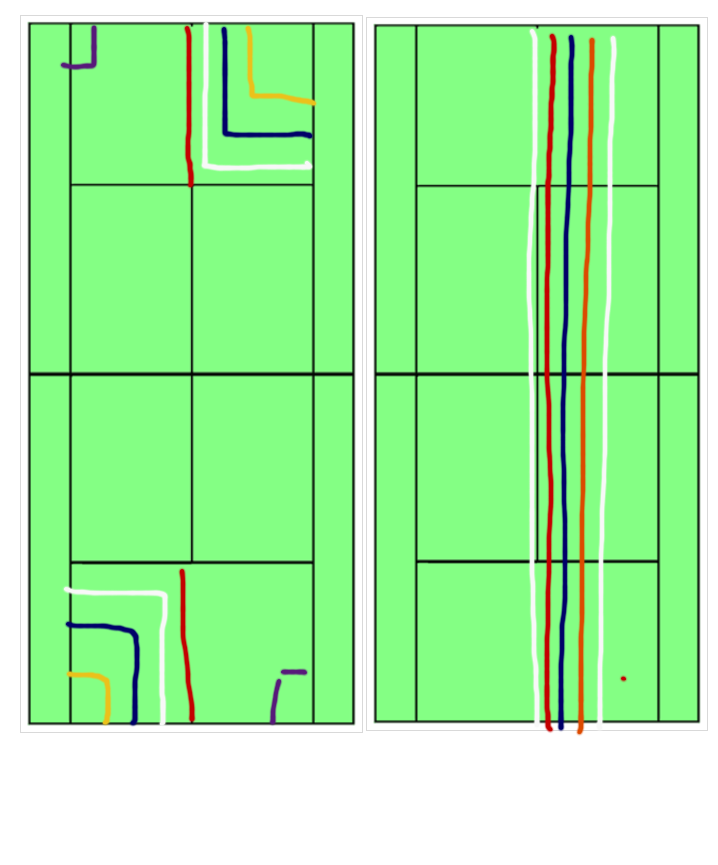 One of the key characteristics of a good tennis player is to have sublime control of the ball. However, one must master ball control in the context of a live point; not when it's fed from a basket. In doesn't matter how well you pound a stationary object because your opponent's primary responsibility is to deliver the ball in such a location, with such spin, height and pace, that you are unable to place your shot exactly as intended. Reference is hereby made to our prior tip where we are stressing juniors' need to practice more against other juniors with a can of balls as opposed of constantly being fed balls from a basket. Speaking of which, is it just me, or does your practice partner's missed feed cause a great deal of consternation?! I don't know about you, but one of my all-time greatest pet peeves is when a 15+ year old misses the feed. After hitting 1,000s of fed balls you'd think that they would have mastered making the first ball in the court. When a practices partner misses a feed, it's either a sign of incompetence or lack of concentration - both signs of disrespect for the nature of the situation. But I digress.
One of the key characteristics of a good tennis player is to have sublime control of the ball. However, one must master ball control in the context of a live point; not when it's fed from a basket. In doesn't matter how well you pound a stationary object because your opponent's primary responsibility is to deliver the ball in such a location, with such spin, height and pace, that you are unable to place your shot exactly as intended. Reference is hereby made to our prior tip where we are stressing juniors' need to practice more against other juniors with a can of balls as opposed of constantly being fed balls from a basket. Speaking of which, is it just me, or does your practice partner's missed feed cause a great deal of consternation?! I don't know about you, but one of my all-time greatest pet peeves is when a 15+ year old misses the feed. After hitting 1,000s of fed balls you'd think that they would have mastered making the first ball in the court. When a practices partner misses a feed, it's either a sign of incompetence or lack of concentration - both signs of disrespect for the nature of the situation. But I digress.
How do you know how good of a player you are if you never practice consistency and ball control?! This skill can only be properly practiced through a live-ball scenario. In this first drill (picture on the left), the players play cross-court backhands and/or forehands. This is a drill where the players can play up to 11. Initially, they both get to use one half of the court (within the red lines). After a player wins a point, the opponent's side of the court "shrinks". That is, the player who won a point now must hit within the opponent's "white" lines. If he wins another point, the player who won must hit the ball within the opponent's "blue" line. As the opponent's side of the court shrinks, the opponent will have a greater chance of winning the point; so, in theory, the opponent will be in a better position to win the point. Eventually, the players will play within the deep corners only. When this happens, the opposite corner "opens up". At this point, the players can play cross-court but may also hit down the line for the deep corner on the deuce side. Of course, if you miss, you lose the point so select your shot for going down the line carefully. If you hit it, the opponent can still chase it down and hit it back (either deep backhand corner or go for the risky shot cross-court in your deuce corner).
In the second drill, the partners play down the line but the court shrinks outwards towards the sideline. Same rules; play up to 11. Feel free to put zones in the deep corners on the other half of the court and use those targets similarly to the drill above. Again, the purpose of these drills is to practice controlling the ball in an intended area. Often times, juniors aim for one target and miss it by 15-20 feet. If they aim for the lines, chances are that they will miss the court by feet, not inches. Some juniors hit the ball incredibly hard but cannot master a simple 5-ball rally that should be basic for anyone within 1 or 2 years of playing experience. Remember, "you are only as good as your opponent allows you to be;" if you do not have an easy sitter, you will have to grind. Grinding entails adjustment to whatever your opponent throws your way without sacrificing positioning or granting an opening to the opponent. In addition, when your goal is to play in college, one additional thing to keep in mind is that you don't just have to win for the team, you also have to be a good practice partner for your team-mates. All workouts have a dual-benefit component where both players must benefit equally from the practice.